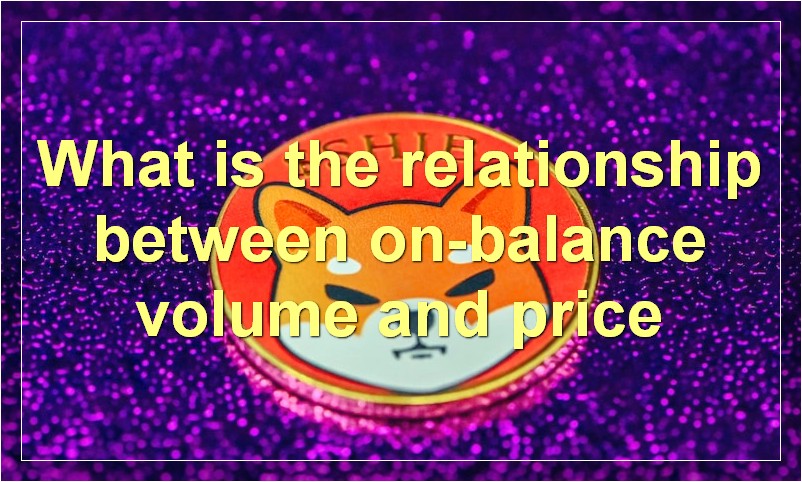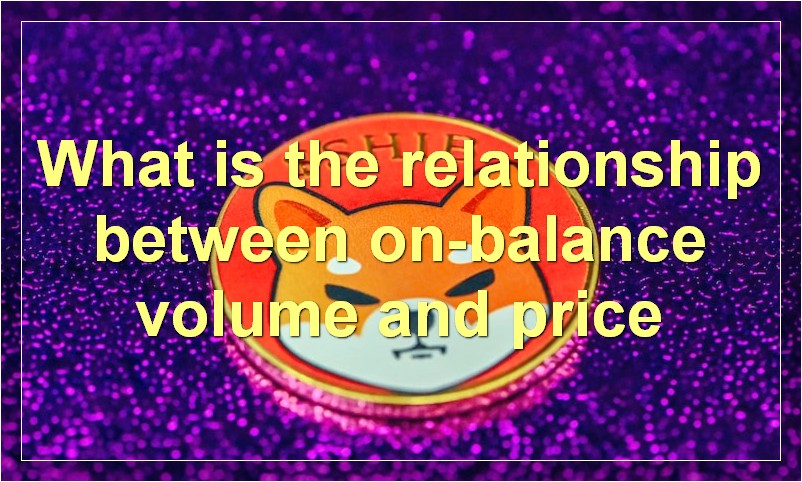On-balance volume is a technical analysis indicator that uses volume to predict changes in stock price. OBV measures buying and selling pressure as a cumulative total, and it can be used to identify trend reversals, trend strength, and potential breakout stocks.
What is on-balance volume
On-balance volume is a technical indicator that uses volume data to show changes in stock price. It is used to predict future price movements and trends.
The on-balance volume indicator (OBV) was developed by Joseph Granville in the early 1960s. Granville believed that volume precedes price, so he created OBV to show how volume was related to price changes.
The OBV formula is simple:
OBV = the today’s closing price – yesterday’s closing price
If today’s closing price is higher than yesterday’s, then the OBV is positive. If today’s closing price is lower than yesterday’s, then the OBV is negative. The OBV line is plotted on a chart with the stock’s price.
When the stock price goes up and the OBV also goes up, it confirms the uptrend. When the stock price goes down and the OBV goes down as well, it confirms the downtrend. If there is a divergence—meaning the stock price goes up but the OBV goes down, or vice versa—it signals a possible trend change.
The OBV can be used with other technical indicators to confirm trends or reversals. For example, if the stock price is going up but OBV is going down, it might be time to sell.
The OBV can also be used to spot divergences, which are periods when the stock price and OBV move in opposite directions. A bullish divergence occurs when the stock price makes a new low but OBV doesn’t. A bearish divergence happens when the stock price makes a new high but OBV doesn’t. These divergences can signal a coming trend change.
What is the relationship between on-balance volume and price

On-balance volume is a technical indicator that uses volume to predict changes in stock price. The theory is that when the volume of trading is high, it indicates that there is strong interest in the stock, and the price is likely to go up. Conversely, when volume is low, it indicates that there is less interest in the stock, and the price is likely to go down.
OBV can be used to confirm other indicators or signals. For example, if the price of a stock is rising and OBV is also rising, this may be seen as a confirmation that the price trend is strong and likely to continue. However, if the price is rising but OBV is falling, this may be seen as a sign that the price trend is losing momentum and could reverse.
OBV can also be used to identify divergences, which are times when the direction of OBV and price are not in sync. A bullish divergence occurs when the OBV line starts to rise while the price is still falling, which may be a sign that the sell-off is losing steam and the stock could soon start to rise. A bearish divergence occurs when the OBV line starts to fall while the price is still rising, which may be a sign that the rally is running out of steam and the stock could soon start to fall.
How is on-balance volume used to make trading decisions
The on-balance volume (OBV) is a momentum indicator that uses volume flow to predict changes in stock price. Joseph Granville first developed the OBV in the early 1960s.
Traders use OBV to make decisions about when to buy or sell a security. If the OBV is increasing, it means that volume is flowing into the security, and prices are likely to rise. If the OBV is decreasing, it means that volume is flowing out of the security, and prices are likely to fall.
Some traders also use the OBV to confirm other technical indicators. For example, if the OBV is rising along with prices, it may be a confirmation that prices will continue to rise.
The OBV can be used on any time frame, but it is most commonly used on daily or weekly charts.
What are the benefits of using on-balance volume
On-balance volume is a technical indicator that uses volume data to show changes in supply and demand. It is calculated by taking the difference between the volume of stock traded on days when the security closes higher than it did the previous day and the volume of stock traded on days when the security closes lower than it did the previous day. This indicator can be used to confirm price trends or to predict future price movements.
What are the limitations of using on-balance volume
On-balance volume is a technical analysis tool that uses volume data to predict changes in stock price. OBV is based on the premise that price and volume are related: if volume is increasing, then prices will rise, and if volume is decreasing, prices will fall. However, there are several limitations to using OBV as a trading strategy.
First, OBV can be lagging. By the time OBV signals a change in price direction, the move may already be over. Second, OBV is a cumulative indicator, meaning that it doesn’t take into account the price of each individual trade. This can lead to false signals in choppy markets. Finally, like all technical indicators, OBV is subject to interpretation, so two different traders may come to different conclusions about the same data.
How can on-balance volume be used to predict future price movements

On-balance volume (OBV) is a technical indicator that measures buying and selling pressure. OBV is calculated by taking the difference between the volume of shares traded on days where the stock price closes higher than it did the previous day, and the volume of shares traded on days where the stock price closes lower than it did the previous day. This information is then cumulative, so that each day’s OBV is added to the total from the previous day.
OBV can be used as a leading indicator to predict future price movements. When OBV is rising, it means that there is more buying than selling pressure, and that prices are likely to continue to rise. When OBV is falling, it means that there is more selling than buying pressure, and prices are likely to fall.
To use OBV to predict future price movements, look for divergence between OBV and price. If OBV is rising but price is falling, it may be a sign that prices are about to turn around and start rising. Conversely, if OBV is falling but price is rising, it may be a sign that prices are about to turn around and start falling.
What are some common misconceptions about on-balance volume
There are a few common misconceptions about on-balance volume (OBV), which is a technical indicator used to measure buying and selling pressure. Some believe that OBV is a lagging indicator, meaning it only tells you what has happened in the past and not what will happen in the future. Others think that OBV is too simple and doesn’t take into account important factors like price or time.
Despite these misconceptions, OBV can be a helpful tool for traders and investors. It’s important to remember that OBV is just one indicator and should not be used as the sole basis for making trading decisions. However, when used in conjunction with other technical indicators, OBV can provide valuable insights into market trends.
How can on-balance volume be combined with other technical indicators
On-balance volume (OBV) is a momentum indicator that uses volume flow to predict changes in stock price. OBV is calculated by using a running tally of positive and negative volume. If the volume is positive, then the tally is increased by the volume; if the volume is negative, then the tally is decreased by the volume. The resulting number is the OBV.
OBV can be used in conjunction with other technical indicators to provide a more complete picture of market conditions. For example, OBV can be combined with support and resistance levels to help identify potential breakouts. When OBV is rising and price is testing a resistance level, a breakout may occur if enough buying volume comes in. On the other hand, if OBV is falling and price is testing a support level, a breakdown may occur if enough selling volume comes in.
OBV can also be used with moving averages to help confirm trend direction. For example, if price is above a 200-day moving average and OBV is rising, this may be confirmation that the uptrend is strong. Conversely, if price is below a 200-day moving average and OBV is falling, this may be confirmation that the downtrend is strong.
Combining OBV with other technical indicators can help provide a more complete picture of market conditions and aid in making trading decisions.
What role does on-balance volume play in technical analysis
On-balance volume is a technical indicator that uses volume data to predict changes in stock price. OBV is calculated by taking the difference between the day’s volume (the number of shares traded) and the previous day’s volume. If the stock price is up on the day, the difference is positive; if the stock price is down on the day, the difference is negative. The OBV line is then plotted on a chart with the stock price.
OBV can be used to confirm price movements or predict future price movements. For example, if the stock price is rising and the OBV line is also rising, this is confirmation that the price movement is bullish (upwards). If the stock price is falling and the OBV line is also falling, this is confirmation that the price movement is bearish (downwards).
If the stock price is rising but the OBV line is falling, this may be a sign that the rally is losing steam and that prices could soon start to fall. Conversely, if the stock price is falling but the OBV line is rising, this may be a sign that prices could soon start to rise as buyers step in.
OBV can also be used to predict future price movements. If the OBV line starts to rise before the stock price starts to rise, this may be a sign that prices are about to start rising. Similarly, if the OBV line starts to fall before the stock price starts to fall, this may be a sign that prices are about to start falling.
Is on-balance volume the only volume-based indicator used by traders
On-balance volume (OBV) is a technical analysis indicator used to measure buying and selling pressure. OBV is calculated by taking the difference between the volume of shares traded on up days and the volume of shares traded on down days. A positive OBV value indicates net buying pressure, while a negative OBV value indicates net selling pressure.
OBV is not the only volume-based indicator used by traders. Other popular volume indicators include the Accumulation/Distribution Line (A/D line) and the Ease of Movement (EOM) indicator.

